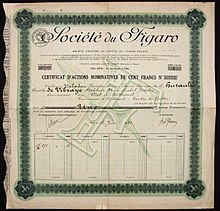Le Figaro
| Le Figaro | |
|---|---|
|
|
|
| description | daily newspaper |
| language | French |
| Headquarters | Paris |
| First edition | January 15, 1826 as a satirical newspaper since 1866 as a daily newspaper |
| Frequency of publication | Every day |
| Sold edition | 306,737 copies |
| (OJD 2017) | |
| Editor-in-chief | Alexis Brézet |
| editor | Socpresse / Dassault |
| Web link | lefigaro.fr |
| ISSN (print) | 0182-5852 |
Le Figaro is an economically liberal and socially conservative French daily newspaper . The national newspaper published in Paris is, along with Le Monde, the most important opinion-forming newspaper in France. Le Figaro was founded in 1826 as a satirical newspaper . This makes it the oldest French newspaper still published today. In 1866 it became a daily newspaper. Today it is considered the most important conservative medium.
background
The sold circulation was 339,236 in 2007, 325,509 in 2010 and 320,732 copies in 2014.
Since June 2004, Le Figaro has belonged to the aviation entrepreneur and LR politician Serge Dassault , who owns around 70 French-language papers. Dassault issued, among other things, an instruction to the editors not to publish any information that could be detrimental to his business interests; this caused controversy in France and also in the editorial office itself. Dassault's biggest competitor is the Groupe Lagardère .
Le Figaro is a founding member of the Leading European Newspaper Alliance (LENA), in which she currently works with the daily newspapers Die Welt , the Italian La Repubblica , El País from Spain, Le Soir from Belgium as well as the Swiss magazines Tages-Anzeiger and Tribune de Genève in the international reporting collaborates editorially and collaborates.
The newspaper has a successful online presence; In addition, the company operates a number of online advertising sites through its Figaro Classifieds branch , including Cadremploi , Keljob and ChooseYourBoss with total sales of around EUR 40 million (2016). In December 2016, the Viadeo social network was bought.
history
Le Figaro was originally founded as a satirical newspaper on January 15, 1826 and named in allusion to the news-broking barber from the plays Le Barbier de Séville and La Folle Journée ou le Mariage de Figaro by Pierre Augustin Caron de Beaumarchais . On the front page you can find the motto Sans la liberté de blâmer il n'est point d'éloge flatteur , in German “Without criticizing freedom there is no flattering praise”. Originally the newspaper appeared irregularly, but the circulation increased. The newspaper has been published daily since 1866, making it the oldest daily newspaper still published in France. Early editors included Albert Wolff , Émile Zola and Jules Claretie . The Futurist Manifesto published by Filippo Tommaso Marinetti in Le Figaro on February 20, 1909 , founded the Futurism movement. In 1914, in a press campaign against Joseph Caillaux , Gaston Calmette , the then editor of 'Le Figaro', threatened to publish love letters from Caillaux's wife Henriette to her husband, who at the time of writing was still married to another woman. Henriette Caillaux then shot Calmette on March 16, 1914 in his editorial office. Joseph Caillaux resigned the next day, took over the defense of his wife in the subsequent process and obtained an acquittal.
After the publication of an article on September 19, 2006, in which, among other things, the ban on string thongs at a beach festival was taken as evidence of an alleged Islamization of France, the paper came under the spotlight of Islamists who then sent threats. In Tunisia, the issue was banned for one day.
From 1883 to 1911, Le Figaro illustré was published as an elaborately designed, color-illustrated supplement that was able to win over important illustrators such as Jules Chéret as designers. The supplement appeared annually until 1890, then monthly. After 1911, weekly illustrated supplements to Figaro appeared under changing titles such as Supplément illustré , Le Figaro artistique , Supplément artistique and Le Figaro artistique illustré (until 1931).
Web links
- “Le Figaro” homepage
- 1826 to 1840 and 1854 to 1942 - Le Figaro available in Gallica , the BnF's digital library .
Individual evidence
- ↑ Le Figaro internationalmediasales.net
- ↑ https://www.eurotopics.net/de/148679/le-figaro
- ↑ Le Figaro. In: ojd.com. OJD (Office de justification de la diffusion), archived from the original on January 29, 2009 ; Retrieved July 31, 2016 (French).
- ↑ Le Figaro - Ciphers. In: ojd.com. OJD (Office de justification de la diffusion), accessed on July 31, 2016 (French).
- ↑ a b Marc Zitzmann: Life as quoted. in France: Why I don't read “Le Figaro” anymore . Neue Zürcher Zeitung , November 11, 2010, accessed on July 31, 2016.
- ↑ Uwe Mantel: “Die Welt” is a co-founder of the newspaper alliance LENA. In: DWDL.de . March 10, 2015, accessed July 31, 2016.
- ↑ Vincent Fagot: Figaro Classifieds, la filiale petites annonces du groupe de médias, reprend Viadeo. In: Le Monde. December 23, 2016 (French).
- ↑ France: Death threats against teachers after criticism of Islam . Spiegel Online , September 28, 2006, accessed July 31, 2016.
- ^ Claire Blandin: Le Figaro: Deux siècles d'histoire. Colin, Paris 2007, ISBN 978-2-200-26877-0
Coordinates: 48 ° 52 ′ 22.8 " N , 2 ° 20 ′ 11.4" E

